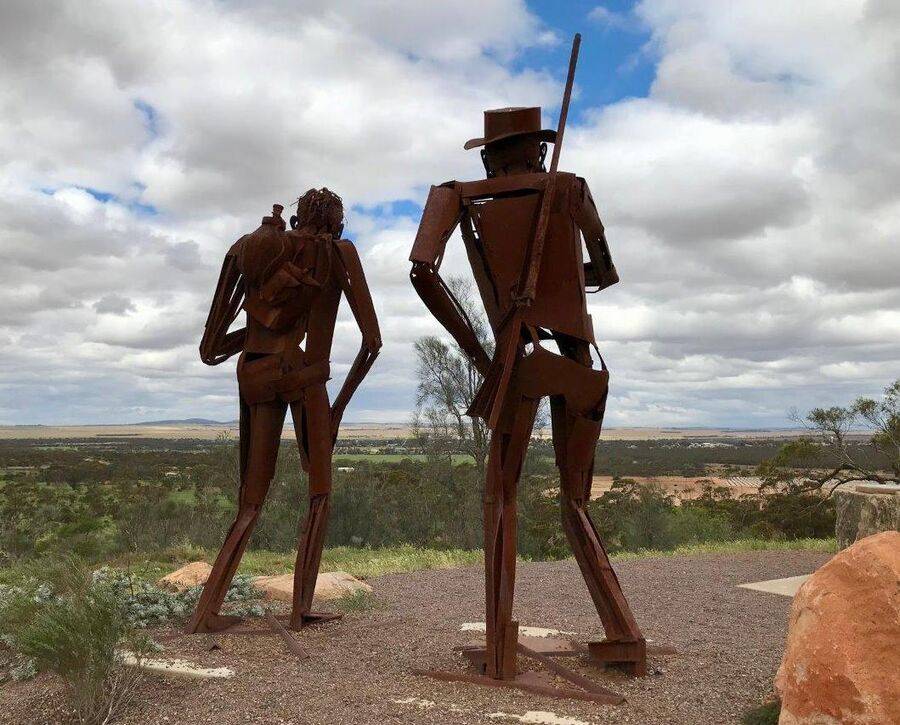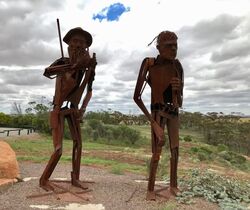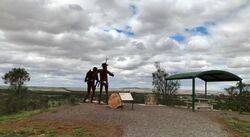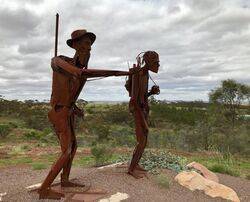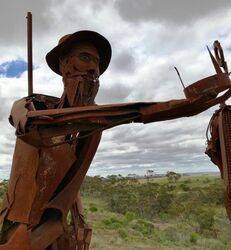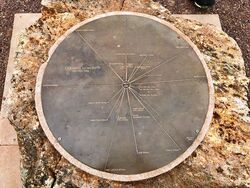
Home » Themes » People » Exploration
Edward John Eyre & Wylie Print Page 
Edward John Eyre (1815 – 1901) was an English land explorer of the Australian continent, colonial administrator, and a controversial Governor of Jamaica.
In December 1837, Eyre started droving 1,000 sheep and 600 cattle overland from Monaro, New South Wales to Adelaide, South Australia. Eyre, with his livestock and eight stockmen, arrived in Adelaide in July 1838. In Adelaide, Eyre sold the livestock for a large profit. With the money from the sale, Eyre set out to explore the interior of South Australia. In 1839, Eyre went on two separate expeditions: north to the Flinders Ranges and west to beyond Ceduna. The northern-most point of the first expedition was Mount Eyre; it was named by Governor Gawler on 11 July 1839 In 1840, Eyre went on a third expedition, reaching a lake that was later named Lake Eyre, in his honor.
Eyre, together with his Aboriginal companion Wylie, was the first European to traverse the coastline of the Great Australian Bight and the Nullarbor Plain by land in 1840 and 1841, on an almost 3218 kilometre trip to Albany, Western Australi. He had originally led the expedition with John Baxter and three aborigines.
On 29 April 1841, two of the aborigines killed Baxter and left with most of the supplies. Eyre and Wylie were only able to survive because they chanced to encounter, at a bay near Esperance, Western Australia, a French whaling ship Mississippi, under the command of an Englishman, Captain Thomas Rossiter, for whom Eyre named the location Rossiter Bay.
Location
| Address: | Tola Road, Whites Nob Scenic Lookout, Kimba, 5641 |
|---|---|
| State: | SA |
| Area: | AUS |
| GPS Coordinates: | Lat: -33.122515 Long: 136.396843 Note: GPS Coordinates are approximate. |
Details
| Monument Type: | Sculpture |
|---|---|
| Monument Theme: | People |
| Sub-Theme: | Exploration |
| Artist: | Roland Weight & Marcus Possingham |
| Link: | http://adb.anu.edu.au/ |
Dedication
| Approx. Monument Dedication Date: | November-2011 |
|---|
Edward John Eyre Sculptures
Edward John Eyre, born in England in 1815, is remembered as the first man to cross this continent from Sydney to the Swan River. He was the first man to record his exploration of the three sides of peninsula named in his honour. Lake Eyre and the Eyre Highway are also named in recognition of his skill, perseverance and courage as an explorer.
In 1838 he led an expedition from Streaky Bay. Passing through sandy terrain and scrubby vegetation, Eyre reached the Gawler Ranges where he identified Sturt`s Pea. Water had been scarce and Eyre was glad to find a good supply at Baxter`s Range, near Iron Knob. The expedition ended at Depot Creek, near Mt Arden. In 1840 this trek was reversed by Eyre`s overseer, John Baxter. Recent rain had ensured adequate water and the party was able to follow the tracks made by their wagons the previous year. Meanwhile Eyre explored the eastern side of the peninsula.
It was very hard for the horses to penetrate the dense vegetation. Feed was scarce and water more so. About 45 kms east of where you are standing, Eyre found good grass and a spring of water. He was so relieved that he named the place Refuge Rocks, "for such they were to us in our difficulties". At Port Lincoln, Eyre arranged for supplies to be shipped from Adelaide. In 1841 Eyre left Port Lincoln and headed north west to Streaky Bay where he met John Baxter. Arrangements were made to ship supplies to Fowler`s Bay and the party set out for W. A. Poor feed and shortage of water so weakened the horses that they we not able to carry all the provisions wanted by the men.
Eyre was determined to explore beyond the Head of the Bight and was very aware of the difficulties ahead. At Fowler`s Bay he sent non-essential supplies and four men back to Adelaide by ship. It was at this stage that Wylie joined the expedition. He was from King George Sound and had accompanied Eyre on previous trips. Lack of water, scarcity of food, difficult terrain and extremes of weather all combined to make this trek along the coast so ardous that men and horses perished. Fortunately for Eyre and Wylie, a whaling ship was anchored at Rossiter`s Bay and the two survivors were able to recuperate sufficiently to finish the trek to Albany.
Erected in November 2011, these stunning figures are an artistic to Edward John Eyre and the indigenous men on whose bush skills he so often relied.
Sculptured by Roland Weight and Marcus Possingham, commissioned by the District Council of KImba Tourism Committee and funded by the District Council of Kimba and a Tourism Development Grant.


